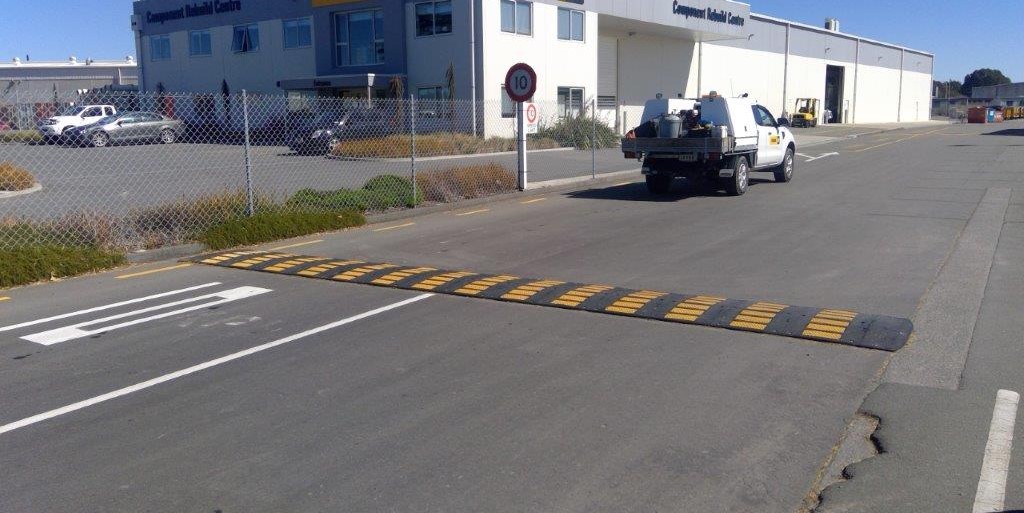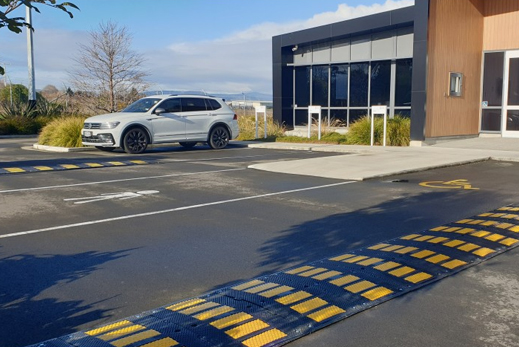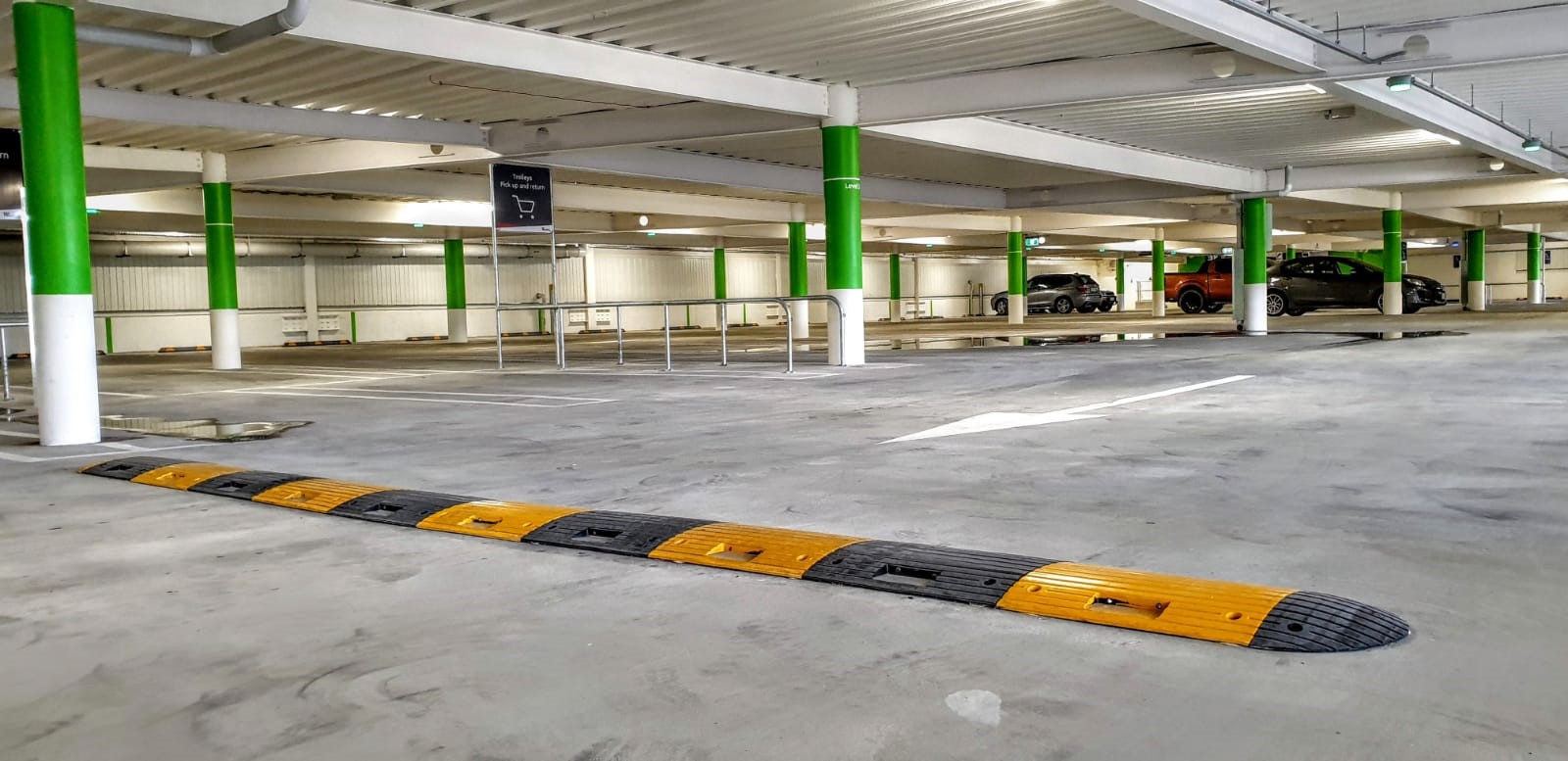If traffic management and site safety are a top priority for your business then you’ve probably considered how you might manage traffic speed. Signs are a great start but physical aides, such as speed humps, offer a visible and sensory speed deterrent. There are dozens of names for these speed-reduction devices, from speed humps, speed bumps, speed calmers to sleeping policeman, and in this article, we’ll cover their different applications.
Choosing the right speed hump, however, is more complex than simply sticking a bump on the road. The type of speed hump you’ll need depends on a number of factors, such as:
- What type of vehicles are you trying to slow down?
- What speed should the vehicles be going?
- Where are the speed humps required?
- What is the ground surface where speed humps are to be installed?
Speed humps are an effective way of slowing down vehicles of all kinds to a safe speed, minimising the risk of accidents involving people/vehicles/buildings/assets. There are different types of speed humps depending on your specific situation and what you’re trying to achieve. An NZTA report outlined that speed is the greatest general factor in determining whether a pedestrian victim is killed. A study in Sweden concluded that the risk of fatal injury at 50kph is twice as high as at 40kph and five times as high as 30kph (Rosén and Sander, 2009).
In this article, we’ll explore the common locations where speed humps are deployed and the considerations that dictate which speed humps are best for each.

Speed cushions in a commercial moderate vehicle activity area.
Speed hump or speed cushion?
When investigating traffic management solutions it’s common to find both speed humps (or speed bumps) and speed cushions mentioned. But what is the difference between them?
Speed humps, or speed bumps, use vertical deflection to reduce a vehicle’s speed. They’re a visual speed reduction device with a physical bump to force the driver to slow. They’re used when a significant slowing of momentum is required, usually when entering a hazardous environment where the driver needs to pay additional attention or maintaining speeds of 10-20km/h in areas such as carparks.
Speed cushions have a low angle gradient so don’t have quite the impact a speed hump has. Speed cushions are excellent in certain situations where a speed hump is not the best choice. Speed Cushions are designed for use on roads and traffic thoroughfares around industrial complexes, loading docks and other locations where heavy vehicles are present on a regular basis. The profile is non-aggressive which suits larger vehicles better.
Get your free copy of our traffic management guide
What’s an appropriate location for speed humps?
As there are many suitable applications for speed humps it’s important to also consider when it may not be suitable to use one. It is not appropriate, for example, to use a rubber speed hump or cushion, on an unsealed surface like gravel, or one that is cracked and falling apart.
Speed humps are incredibly effective at managing hazards. And as most private vehicular traffic routes require lower speeds than public roads their use is almost limitless. So let’s explore how they can be used.

Speed cushions in a public high vehicle and pedestrian activity area.
How to use speed humps for traffic calming
When assessing the perfect traffic calming solution for your workplace it’s important to bear in mind the principle goal and the traffic types using the space. If light passenger vehicles will frequent the area, slightly different speed humps are required versus heavier traffic. Below we list out each solution and the vehicular types it’s best suited towards.
Interlocking speed hump
If you want a standard speed hump to slow down cars/utes/vans and occasional trucks in a carpark or workplace, our 50mm high Interlocking rubber speed hump
is the best solution. They’re highly visible, durable and easy to install. It’s perfect at the entrance to your site to transition traffic from public posted speeds to your posted limits. The modular interlocking system is easily adjusted to fit wider or narrow roadways.
For critical risk areas, such as blind corners, high-risk pedestrian crossings, or compulsory stops, we also have a 75mm high-speed hump which will slow vehicles to almost a complete stop before crossing them.
Reflective cats eyes also enhance visibility at nighttime.
Heavy Duty Speed Cushions
If you need a speed hump to slow down larger vehicles. such as trucks in a distribution centre, we recommend using our heavy-duty rubber speed cushions, available in 50mm or 75mm high profiles. These simulate the effect of an asphalt speed hump while the longer profile creates more of a gentle slope to lessen the impact on trucks and their load, and spread the weight over the ground, resulting in less of a ‘bump.’ These also use an innovative interlocking system enabling you to create a traffic-calming device suited to the required space.
Low traffic volume speed humps
If you are unable to bolt anything into the ground but still want to slow vehicles down, our 1.8m wideeconomy rubber speed hump is a good option as it can be ‘loose laid’ without bolts. It contains dual cable recessing channels to protect cables or air hoses. The reflective elements create excellent nighttime visibility and these can be easily relocated making them the perfect temporary speed management measure.

Speed hump in use at a residential high vehicle and pedestrian activity area.
Heavy-duty speed cushion
If speed management is a top priority then our Heavy Duty Speed Cushion is ideal. Suitable for heavy-duty vehicles and forklifts this is the perfect solution for shared routes with diverse industrial traffic. Durable enough for frequent heavy loads this interlockable design is ideal as an entrance speed control device at a warehouse entrance or loading dock.
Speed cushion pad
As mentioned earlier, speed cushions are excellent for locations where buses, emergency service vehicles and wide-axle vehicles need to pass unimpeded but passenger vehicles require speed reduction. Ideal for public roads and larger worksites where trucks take priority.
Other benefits for speed humps include shaking off vehicles of excess moisture after a wash or settling transport loads after loading and alerting vehicular users to potential hazards. Whether you’re looking for speed humps to slow staff or customer traffic on your site or seeking to improve general vehicular safety we can help. From advising the right speed hump for your needs to full traffic management solutions, the team at Vanguard are specialists in preventing risk.
Here at Vanguard Group, we believe in making it as easy as possible to implement leading safety procedures. We offer full installation services across New Zealand and also make it simple for your contractors to get the job done thanks to our installation instructions on our resources page.
To view our full range of speed humps, click on the button below. If you want to discuss your specific situation, call our team on 0800 500 147 and we can help determine which speed hump you need.
